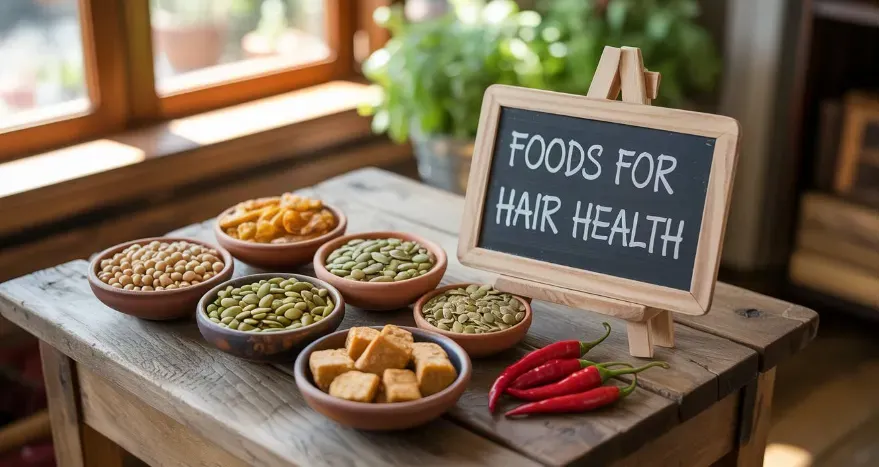Foods That May Help with Hair Loss: What Science Really Says
Key takeaways
- Soy isoflavones and capsaicin have been shown to promote hair growth in controlled studies.
- Pumpkin seed oil supplementation led to a 40% increase in hair counts in men with pattern baldness.
- Dietary patterns rich in raw vegetables, herbs, and plant-based foods may lower the risk of hair loss.
- Supporting gut health through fiber-rich foods could indirectly benefit hair health.
Hair loss can feel like a slow erosion of confidence, whether it’s thinning strands on the crown, widening parts, or receding edges. Androgenetic alopecia—commonly called male or female pattern baldness—is the most widespread form, gradually thinning hair across the central scalp. While genetics and hormones play a significant role, researchers are increasingly asking: can diet and lifestyle influence hair health?
The Role of the Microbiome in Hair Growth
One of the more surprising discoveries comes from the gut. Case reports have documented individuals experiencing renewed hair growth after fecal microbiota transplants—procedures designed to restore balance in the gut microbiome. In at least one instance, a man who had been completely bald began regrowing hair within months and had a full head of hair a year later.
Diet Patterns Linked to Hair Loss Risk
Large population studies show that lifestyle and diet matter. Male pattern baldness has been associated with:- Higher consumption of processed meat and fast food
- Poor sleep quality
- Frequent intake of raw vegetables and fresh herbs
- Regular soy milk consumption
In fact, drinking soy beverages at least once a week was linked to a 62% lower risk of moderate to severe hair loss. Plant compounds such as isoflavones may help by interacting with hormonal pathways that influence hair follicles.

Plant Compounds Studied for Hair Growth
Capsaicin and Soy Isoflavones
Researchers have investigated specific plant-based nutrients in controlled trials. A standout is the combination of capsaicin (the active compound in chili peppers) and soy isoflavones.
- Participants taking 6 mg of capsaicin and 75 mg of isoflavones daily showed significant improvements in hair growth compared to placebo.
- To put this in food terms, that’s roughly a quarter of a fresh jalapeño pepper and ¾ cup of tempeh or boiled soybeans per day.
Pumpkin Seed Oil
Pumpkin seeds are often tossed aside, yet they pack remarkable nutrition. Researchers became interested in pumpkin seed oil after studies showed benefits for men with prostate enlargement, a condition tied to androgen activity. This sparked the question: could it also help with androgen-related hair loss?- Those taking 400 mg of pumpkin seed oil daily (about the equivalent of eating two pumpkin seeds) experienced a 40% increase in hair counts after 24 weeks.
- The placebo group showed only a 10% increase.
- Importantly, there were no negative effects on sexual health.
Nutrient Deficiencies That Can Worsen Hair Loss
Beyond specific compounds, several micronutrients play a pivotal role in hair follicle health. Deficiencies may trigger or worsen hair thinning.
Iron
Low iron, particularly in women, is a common cause of diffuse hair shedding. Iron is crucial for oxygen transport to hair follicles.Zinc
Zinc is involved in protein synthesis and cell repair. Deficiency can lead to brittle hair and increased shedding.Vitamin D
Vitamin D influences follicle cycling. Low levels are linked to alopecia areata and may worsen pattern hair loss.B Vitamins
While biotin deficiency is rare, low levels of certain B vitamins (like folate and B12) may contribute to hair brittleness or loss.Lifestyle Factors That Influence Hair
Sleep
Poor sleep quality has been correlated with higher rates of hair loss. Hormonal balance, repair processes, and stress regulation all depend on adequate rest.Stress
Chronic stress can push hair follicles into a resting phase, leading to increased shedding (telogen effluvium). Stress management through mindfulness, exercise, and relaxation techniques may protect against this.Exercise
Regular physical activity supports circulation and hormonal regulation, indirectly benefitting hair follicles. In practice, supporting hair health means pairing smart nutrition with balanced daily routines.Common Myths and Misconceptions
“Everyone should take biotin.”
Unless you’re deficient, extra biotin won’t accelerate hair growth.“Natural oils and food extracts can cure baldness.”
While pumpkin seed oil shows promise, most topical food-based remedies lack strong evidence in humans.“Shampoo choice determines hair loss.”
Hair loss primarily originates at the follicle level inside the scalp, not from shampoo ingredients—unless harsh chemicals are irritating the skin.Practical Takeaways for Supporting Hair Health
While no single food will “cure” hair loss, dietary habits may tip the scales. Building meals with these foods may help support scalp and follicle health:- Soy foods (edamame, tempeh, tofu, soy milk)
- Chili peppers (even small daily amounts)
- Pumpkin seeds or pumpkin seed oil
- Plenty of fresh vegetables and herbs
Conclusion
Hair loss isn’t dictated by genetics alone. Nutrition research—though still developing—suggests that specific foods and plant compounds may support hair retention and regrowth. From spicy peppers and soy to the humble pumpkin seed, these everyday foods could be allies for healthier hair.References:
- Dhurat R, Sharma A, Rudnicka L, et al. 5-Alpha reductase inhibitors in androgenetic alopecia: Shifting paradigms, current concepts, comparative efficacy, and safety. Dermatol Ther. 2020;33(3):e13379.
- Pham CT, Romero K, Almohanna HM, Griggs J, Ahmed A, Tosti A. The Role of Diet as an Adjuvant Treatment in Scarring and Nonscarring Alopecia. Skin Appendage Disord. 2020;6(2):88-96.
- Rebello D, Wang E, Yen E, Lio PA, Kelly CR. Hair Growth in Two Alopecia Patients after Fecal Microbiota Transplant. ACG Case Rep J. 2017;4:e107.
- Fortes C, Mastroeni S, Mannooranparampil T, Abeni D, Panebianco A. Mediterranean diet: fresh herbs and fresh vegetables decrease the risk of Androgenetic Alopecia in males. Arch Dermatol Res. 2018;310(1):71-6.
- Hosking AM, Juhasz M, Atanaskova Mesinkovska N. Complementary and Alternative Treatments for Alopecia: A Comprehensive Review. Skin Appendage Disord. 2019;5(2):72-89.
- Marshall JT, Doperalski VL. Jalapeno pepper pungency as a quality controll factor for process cheese. J Dairy Sci. 1981;64:627-33.
